Exercises (2269)
Pyramid training (medium-long): 600-800-1000-1500-1000-800-600
Pyramid training
Single run or in strength groups, with the pacemaker controlling the time
Pyramid training is a special type of interval training that can be run extensively (longer sections at a brisk pace) or intensively (shorter sections at a very fast pace). As the name suggests, the effort initially increases continuously (in the form of a staircase) and is then reduced again to the same extent. There is always a trotting break between the efforts, which is measured by the intensity of the effort. The units should be run so fast that an interval can just be added at the end (extensive) or another interval would no longer feel possible (intensive). It is important to concentrate on an optimal running technique, because as soon as you are no longer running "cleanly", you are travelling too fast. The individual intervals are run very quickly, but as evenly as possible (the shorter the effort, the higher the intensity and vice versa). For shorter workouts, you cannot rely completely on the heart rate for intensity levels, as the heart rate only adapts to the exertion with a slight delay at the start of the workout.
Running training with alternating exertion and recovery:
- 600m exertion (intensity level: 4)
- 800m exertion (intensity level: 4)
- 1000m exertion (intensity level: 3-4)
- 1500m exertion (intensity level: 3-4)
- 1000m exertion (intensity level: 3-4)
- 800m exertion (intensity level: 4)
- 600m effort (intensity level: 4)
Pause: 200-400m each time
Intensity level 3:
HFmax: 80-90%
Rule of speech: speak in complete sentences
Intensity level 4:
HFmax: 90-95%
Rule of speech: concise exchange of words
Pyramid training can be completed both on a track and off-road. Running on the track has the advantage that the runner always has control over the distance and the current running pace, which can promote the development of a sense of speed. Whether on the track or off-road, the distances to be covered must be clearly defined for the participants (distance markings). It may also be the case that a turning point is defined if the total distance is not long enough (determine running directions to avoid collisions). After the exertion phase, the participants continue to trot at a relaxed pace until they reach the marker for the next exertion phase (variation: march). To ensure that the participants have enough space for the run, it makes sense to stagger them (spread them out on the track or send them out on the track in a staggered manner). Pyramid training can be carried out as follows:
- Round course: To ensure that the participants have enough space available for the run, they can be spread out on the round course at the start. The participants/groups start the intervals independently, complete the prescribed distances and, if desired, measure the times (note the times so that the same distances are completed in approximately the same time - note-taking is almost impossible to implement in practice). The participants themselves decide how they spend the breaks (e.g. marching or relaxed trotting - however, the same form of recovery should always be maintained in a training session). During the recovery phase, care is taken to ensure that no participants who are in a stress phase are disturbed.
- Distance of at least 1700 metres: Distances are marked with signs (every 25-50 metres). Each participant/group completes the specified distances independently according to the instructions of the sports director (observe running directions so that the total length of the course is sufficient). The times for the respective sections of the course can be recorded independently by the participants if desired (comparison of identical sections). The participants/groups cover the distances to the start of the next interval by marching or at a relaxed trot (keep the same form for training). There is the option of staggering the start of the participants, whereby the running routes must be clearly defined in order to avoid collisions.
- Long-distance circuit: The distances are marked with signs (every 25-50 metres). In the recovery phases, the participants/groups march or trot until the next interval start is marked (always choose the same type of break in a training session). The participants can time the different sections of the course so that the same distances can be compared with each other. After the last interval unit, all runners return to the starting point, which takes additional time. Ideally, the running distance corresponds approximately to the distance that can be covered in the time available in order to generate as little additional displacement time as possible (e.g. 7.9km with 3x200m, 2x300m and 1x400m break sections).
Distance markers (signs with metres)
Evaluation FTA (group formation)
Participant:
1 heart rate monitor
Participant/group:
1 stopwatch
Pyramid training (medium-long): 600-800-1200-1500-1200-800-600
Pyramid training
Single run or in strength groups, with the pacemaker controlling the time
Pyramid training is a special type of interval training that can be run extensively (longer sections at a brisk pace) or intensively (shorter sections at a very fast pace). As the name suggests, the effort initially increases continuously (in the form of a staircase) and is then reduced again to the same extent. There is always a trotting break between the efforts, which is measured by the intensity of the effort. The units should be run so fast that an interval can just be added at the end (extensive) or another interval would no longer feel possible (intensive). It is important to concentrate on an optimal running technique, because as soon as you are no longer running "cleanly", you are travelling too fast. The individual intervals are run very quickly, but as evenly as possible (the shorter the effort, the higher the intensity and vice versa). For shorter workouts, you cannot rely completely on the heart rate for intensity levels, as the heart rate only adapts to the exertion with a slight delay at the start of the workout.
Running training with alternating exertion and recovery:
- 600m exertion (intensity level: 4)
- 800m exertion (intensity level: 4)
- 1200m exertion (intensity level: 3-4)
- 1500m exertion (intensity level: 3-4)
- 1200m exertion (intensity level: 3-4)
- 800m exertion (intensity level: 4)
- 600m effort (intensity level: 4)
Pause: 200-400m each time
Intensity level 3:
HFmax: 80-90%
Rule of speech: speak in complete sentences
Intensity level 4:
HFmax: 90-95%
Rule of speech: concise exchange of words
Pyramid training can be completed both on a track and off-road. Running on the track has the advantage that the runner always has control over the distance and the current running pace, which can promote the development of a sense of speed. Whether on the track or off-road, the distances to be covered must be clearly defined for the participants (distance markings). It may also be the case that a turning point is defined if the total distance is not long enough (determine running directions to avoid collisions). After the exertion phase, the participants continue to trot at a relaxed pace until they reach the marker for the next exertion phase (variation: march). To ensure that the participants have enough space for the run, it makes sense to stagger them (spread them out on the track or send them out on the track in a staggered manner). Pyramid training can be carried out as follows:
- Round course: To ensure that the participants have enough space available for the run, they can be spread out on the round course at the start. The participants/groups start the intervals independently, complete the prescribed distances and, if desired, measure the times (note the times so that the same distances are completed in approximately the same time - note-taking is almost impossible to implement in practice). The participants themselves decide how they spend the breaks (e.g. marching or relaxed trotting - however, the same form of recovery should always be maintained in a training session). During the recovery phase, care is taken to ensure that no participants who are in a stress phase are disturbed.
- Distance of at least 2000 metres: Distances are marked with signs (every 25-50 metres). Each participant/group completes the specified distances independently according to the instructions of the sports director (observe running directions so that the total length of the course is sufficient). The times for the respective sections of the course can be recorded independently by the participants if desired (comparison of identical sections). The participants/groups cover the distances to the start of the next interval by marching or at a relaxed trot (keep the same form for training). There is the option of staggering the start of the participants, whereby the running routes must be clearly defined in order to avoid collisions.
- Long-distance circuit: The distances are marked with signs (every 25-50 metres). In the recovery phases, the participants/groups march or trot until the next interval start is marked (always choose the same type of break in a training session). The participants can time the different sections of the course so that the same distances can be compared with each other. After the last interval unit, all runners return to the starting point, which takes additional time. Ideally, the running distance corresponds approximately to the distance that can be covered in the time available in order to generate as little additional displacement time as possible (e.g. 8.3km with 3x200m, 2x300m and 1x400m interval sections).
Distance markers (signs with metres)
Evaluation FTA (group formation)
Participant:
1 heart rate monitor
Participant/group:
1 stopwatch
Pyramid training (medium): 45-60-90-60-45
Pyramid training
Single run or in strength groups, with the pacemaker controlling the time
Pyramid training is a special type of interval training that can be run extensively (longer sections at a brisk pace) or intensively (shorter sections at a very fast pace). As the name suggests, the effort initially increases continuously (in the form of a staircase) and is then reduced again to the same extent. There is always a trotting break between the efforts, which is measured by the intensity of the effort. The units should be run so fast that an interval can just be added at the end (extensive) or another interval would no longer feel possible (intensive). It is important to concentrate on an optimal running technique, because as soon as you are no longer running "cleanly", you are travelling too fast. The individual intervals are run very quickly, but as evenly as possible (the shorter the effort, the higher the intensity and vice versa). For shorter workouts, you cannot rely completely on the heart rate for intensity levels, as the heart rate only adapts to the exertion with a slight delay at the start of the workout.
Running training with alternating effort and recovery:
- 45 seconds of effort (intensity level: 4-5) - 45 seconds of rest
- 60 seconds of effort (intensity level: 4-5) - 60 seconds of rest
- 90 seconds of effort (intensity level: 4) - 60 seconds of rest
- 60 seconds of effort (intensity level: 4-5) - 45 seconds of rest
- 45 seconds of effort (intensity level: 4-5)
Intensity level 4:
HFmax: 90-95%
Rule of speech: brief exchange of words
Intensity level 5:
HFmax: 95-100%
Rule of speech: No more exchange of words possible
The pyramid training can be carried out as follows:
- Round track: To ensure that the participants have enough space available for the run, they can be spread out on the round track for the start. The sports director has all participants in view and can therefore start or stop the intervals by signalling. The participants decide for themselves how to spend the breaks (e.g. on the spot, marching or at a relaxed trot).
- Distance of at least 700 metres: Distances are marked with signs (every 25-50 metres). Each participant receives a stop/pulse watch, runs along the specified route for the duration of the respective exercise (observe the running directions as specified by the sports director so that the total length of the route is sufficient) and calculates the distance covered. It is possible for participants to start in stages, whereby the running routes must be determined in order to avoid collisions. If the course allows it, the sports director can give the start/stop signal for all participants (no staggering possible).
- Longer distance race: The distances are marked with signs (every 25-50m). Each participant receives a stop/pulse watch, runs the course independently and calculates the distance travelled (no staggered start of the participants necessary). During the breaks, participants wait in place or continue running at a relaxed trot until the break time has elapsed. After the last run, all runners return to the starting point, which takes additional time. Ideally, the running distance corresponds approximately to the distance that can be covered in the time available in order to generate as little additional displacement time as possible.
With the same duration of exertion, an attempt is made to ensure that the participants/groups also reach the same distance. However, there is very little time to calculate and record the distances, which makes it difficult to compare runs of the same duration in practice.
Distance markers (signs with metres)
1 signalling instrument (e.g. whistle)
FTA evaluation (group formation)
Per participant:
1 heart rate monitor
For sports leader or per participant/group:
1 stopwatch
Cross stand
Coordination exercises
Individual work
Both feet point in the same direction, the gaze and shoulders are directed towards the end point of the slackline, the arms are at a 90 degree angle to the slackline (slalckline and arms form a '+' sign), feet at least hip-width apart, knees slightly bent.
Lighten the load:
Perform the exercise close to the attachment; stretch the slackline tightly over a short distance (3-5m); sit a partner in the middle of the slackline to dampen the initial trembling; help a partner by holding their hand (always go with the balancing movement and only stabilise if the slackliner is about to fall).
Make it harder:
Stretch the slackline over a long distance.
1 Slackline
Rad
Floor and apparatus gymnastics









Stepping position, arms held high, pushing leg in front, lifting the swinging leg and lowering the torso, placing the front hand on the floor and turning the body to the side, pushing with the pushing leg and placing the second hand, swinging up to a straddled side handstand, quickly lowering and placing the swinging leg and then straightening up to stand upright.
Variant:
One-handed wheel, jumped wheel, wheel turn (rondat).
The participants practise the movement form independently using series of pictures or based on the instructor's demonstration of the exercise. The instructor (or a partner) gives feedback, provides support and checks that the exercise is being performed correctly.
4 soft mats (small) ► indoor version
1 row
outdoor:
turf field
Wheel turn
Floor and apparatus gymnastics









Hops, forward swing of the arms, placing the front leg on the floor, placing the arms on the floor and swinging into the side handstand (back hand parallel and front hand transverse to the direction of movement), closing the legs, push-off from the shoulders with a slight turn to land in the standing position facing the starting position.
The participants practise the movement form independently using series pictures or based on the demonstration of the exercise by the sports instructor. The instructor (or a partner) gives feedback, provides support and checks the correct execution of the exercise.
4 soft mats (small) ► indoor version
1 row
outdoor:
turf field
Reaction trapping
Coordination exercises
Partner work
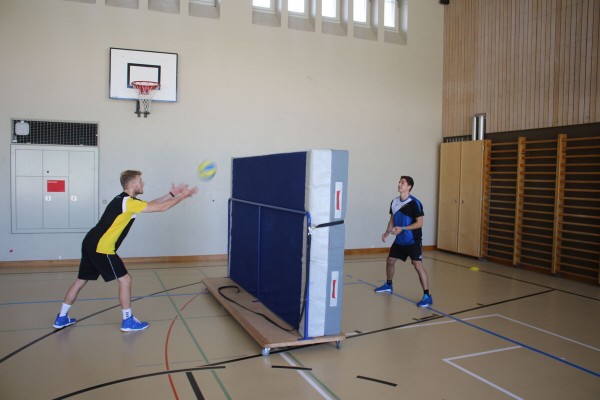
The participants throw a volleyball to each other over a thick mat into a field of approx. 5-6 metres defined by marker cones. To prevent an opponent scoring a point, the ball must be caught before it touches the ground. Throws that do not reach the playing field or get stuck on the mat result in a point for the opponent. Throws are only allowed from bottom to top.
► Reactivity
1 mat trolley (large; incl. mat)
1 volleyball
4 cones
Post setup:
The mat trolley serves as a boundary between the two halves of the playing field. The size of the playing field is marked with cones
Reaction trapping
Coordination exercises
Partner work
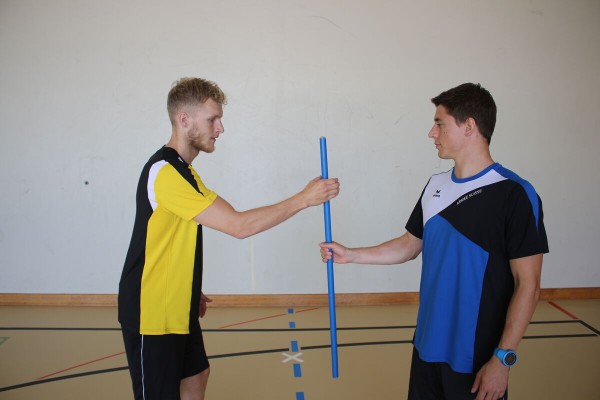
One participant supports themselves with their forearm on a vaulting box and holds their hand slightly open. His partner holds a stick (or floorball stick) in the opening of the active participant's hand (distance between palm and stick: approx. 1cm) with the end of the stick at the bottom edge of the hand. If the partner drops the stick, the active participant tries to catch it as quickly as possible.
Variant:
Perform the exercise simultaneously with both hands and one stick per hand. Only one stick is dropped at a time (choice reaction).
► Reactivity
1 vaulting box
1-2 (wooden) sticks or floorball sticks
Reaction trapping
Coordination exercises
Partner work

One participant sits on the floor with their back against the vaulting box. His legs are spread apart, his arms are held out in front of him and his gaze is fixed on a marker cone about 5-6 metres in front of him. The partner kneels/stands on the vaulting box and drops a foam/softball with their arms outstretched forwards. The seated participant tries to catch the ball before it falls to the floor. After a few attempts, the roles are swapped.
► Reactivity
1 vaulting box ► indoor version
1 marker cone/cap
1 foam/softball
Indoor set-up:
A marker cone/cap is located approximately 5-6 metres from the vaulting box.
Outdoor version:
Without vaulting box; the partner stands on the ground.
Reaction pass game
Coordination exercises
Partner work
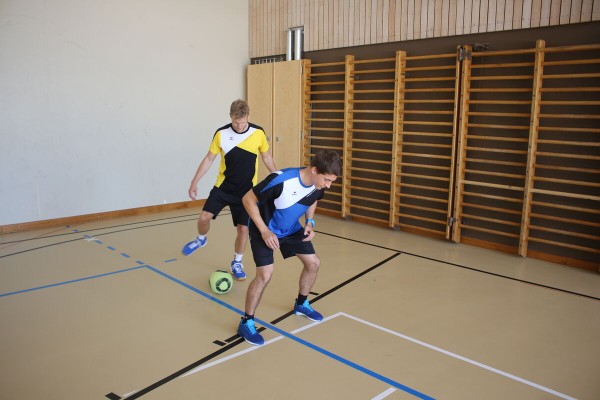
The participants stand behind each other, the participant at the back is equipped with a futsal/football. The person behind passes the ball to their partner from behind between their legs or throws it forwards over their partner's head. The partner must react as quickly as possible and intercept/stop the ball as early as possible. After a few attempts, the roles are reversed.
► Reactivity
1 Futsal/football
Reaction pass game
Coordination exercises
Partner work

A participant stands on a pommel horse. He has his hands stretched out to the side and is holding a volleyball in each hand. The second participant stands approx. 1-2 metres in front of the pommel horse and throws another volleyball to the participant standing on the horse. If the pass goes to the head, the ball is passed back with the head. If the pass comes to the feet, the ball is passed back with the left or right foot (depending on the side of the pass). If the pass comes to one of the outstretched arms, the ball held in the hands must be passed to the partner and the new ball must be caught. The passer can make the exercise easier or more difficult by looking at where the pass is made or not. After a few attempts, the roles are swapped.
► Balance and reaction skills
1 pommel horse
3 volleyballs
Rulebook
Miscellaneous
The sports manager explains the rules of the game form used in the main part to the participants (including organisational information).
Tyre guard
Forms of play / exercises
Group work
2 teams
Two teams play against each other in a limited playing area. A point is scored if a pass is made to a teammate who has at least one leg in a hoop. The defending team can block a hoop by placing a foot in it so that no points can be scored there (more hoops than defenders are needed for this type of exercise). The right to attack changes either after a certain time or after each loss of the ball or disc. The rules of the respective game form naturally apply (e.g. Smolball, Intercrosse/Lacrosse, Floorball, Frisbee Ultimate, Howler).
Variant I:
The exercise form can be played with all balls, throwing discs or game equipment. The throwing/passing technique or passing technique can be specified.
Variant II:
Use more than one ball.
Participant:
1 stick/stick ►Intercrosse/Lacross, Smolball, Floorball
1-3 balls ►Basketball, Blitzball/Touchrugby, Frisbee Ultimate, FooBaSKILL, Futsal/Football, Handball, Intercrosse/Lacross, Smolball, Tchoukball, Floorball
4 marking cones/caps ►Field markings (optional)
x hoops
x playing ribbons/rubbers ►Team identification
Tyre jumping
Coordination exercises
Individual work
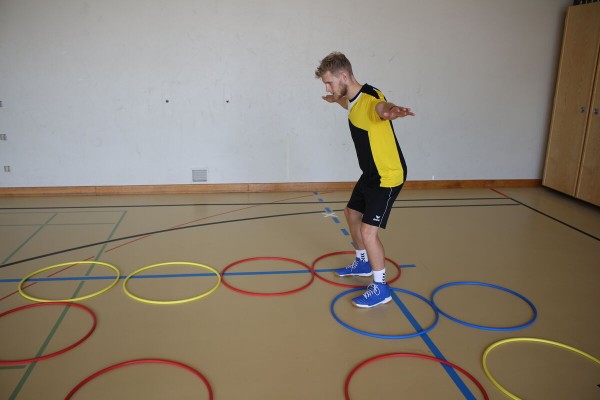
The participant hops over the tyres distributed on the floor. If two hoops are at the same height, both legs are used. Individual hoops are passed with the leg corresponding to the respective side. The hoops can be jumped through forwards or backwards. To make hoop jumping more difficult, the respective arm on the same or even opposite side can be lifted or stretched to the side at the same time when standing.
► Rhythmisation ability, orientation ability, balance ability
20-30 tyres
Post set-up:
Lay out the tyres to form a jumping course.
Tyre relay
Forms of play / exercises
Group work
4-6 participants per group
The first participant in the group runs (alone) to the turnaround, slips through a tyre there and runs back to the group. Now the first participant runs with the second participant (holding hands) to the turning point, where they have to slip through the tyre again. The hands must not be released. This scenario is repeated until the entire group has slipped through the hoop (together with constant hand grasping). After this round, the first participant (who has travelled the longest so far) is allowed to disengage and the remaining group members continue the exercise. Finally, only the participant who was the last to join the group runs. At the end, all participants in the group have completed the same number of runs. Which group was the first to complete the task?
Per group:
2 colouring sticks
1 tyre
Tyre pulling
Fighting and roughhousing games
Partner work
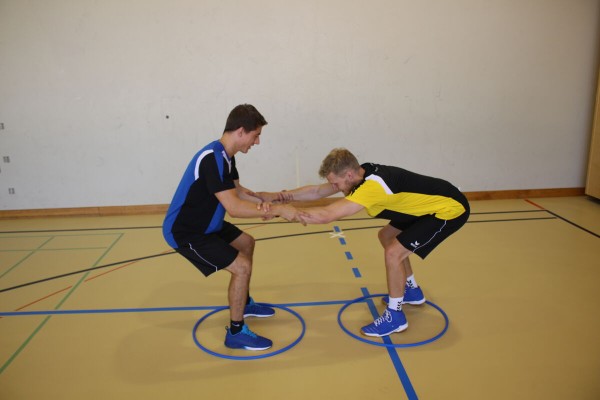
Two participants stand opposite each other in a hoop and grab each other by the hands or forearms. They try to push or pull their opponent out of the hoop. The first person to touch the ground outside the tyre loses.
2 tyres
Reserve
Miscellaneous
The sports manager plans a reserve in the main part so that there is certainly no lack of time (e.g. additional breaks are necessary, postponement time could take longer, post changes are less speedy, etc.).
Rescue and transport
Power
Partner work
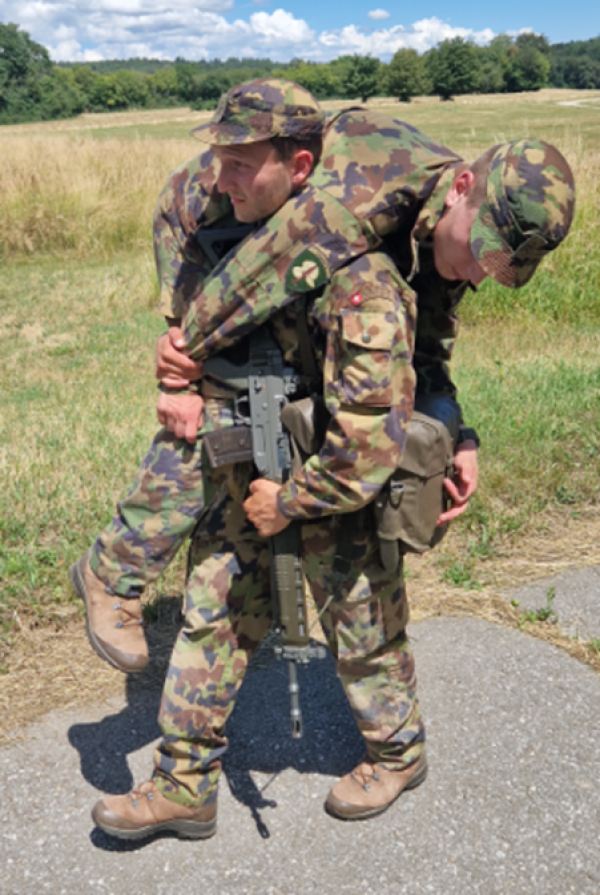
Transport your comrade from one fanjon to another (Gamstrage grip) using the transport techniques from the regulations for self-help and comrade assistance (59.005).
Attention:
The back must be straight when lifting the comrade.
Material per participant: Tenue CNG 428
Additional material: 2 fanjons
Risk run
Forms of play / exercises
Group work
4-5 participants per group
The front runners compete against each other (the group can determine the order of the runners accordingly) and collect points for their group. The runners choose between reversal points at different distances (e.g. colouring stick, marker cone or cones). More risk (further distance) is rewarded with more points (3 points, 2 points, 1 point), but only the first to arrive receives the points scored, the rest go home empty-handed only the first two (or more, depending on the number of groups, e.g. the first two teams) receive points. Which group has the most points after a run (each group member completes one run), or which group is the first to score a number of points? Each run only starts at the signal of the game leader.
Possible forms of locomotion:
- four-footed forwards/backwards
- in a push-up position with a partner holding the legs up
- gamstrage grip
Per group:
4 colouring sticks
Roll backwards
Floor and apparatus gymnastics






From a standing position, roll backwards and place your feet on the floor behind your hands as quickly and as close as possible to return to a standing position. Curl your upper body like a turtle shell during the entire rolling movement from the top of your head to your tailbone. Roll over the upper back and shoulders and not over the head.
The participants practise the form of movement independently using series of pictures or based on the instructor's demonstration of the exercise. The instructor (or a partner) gives feedback, provides support and checks that the exercise is being performed correctly.
4 soft mats (small) ► indoor version
1 row
outdoor:
turf field
Roll backwards through the handstand (Streuli)
Floor and apparatus gymnastics









Roll backwards from an upright position, placing your feet on the floor as quickly and as close as possible behind your hands. Curl your upper body like a turtle shell during the entire rolling movement from the top of your head to your tailbone. Roll over the upper back and shoulders and not over the head. At the end of the roll, push your body into a handstand (full body stretch). The arms can be bent at first and then stretched or remain stretched throughout the movement. From the handstand, place the legs on the floor to return to the standing position.
In order to be able to perform this sequence of movements, it is necessary to be able to roll forwards and backwards, have appropriate support in the arms and master the tilt kick movement.
The participants practise the form of movement independently using series pictures or based on the demonstration of the exercise by the sports leader. The sports instructor (or a partner) gives feedback, provides support and checks that the exercise is being performed correctly.
4 soft mats (small) ► indoor version
1 row
outdoor:
turf field
Roll forwards and backwards
Floor and apparatus gymnastics




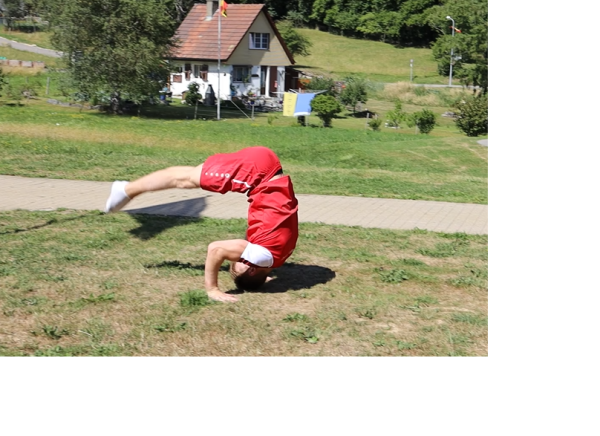


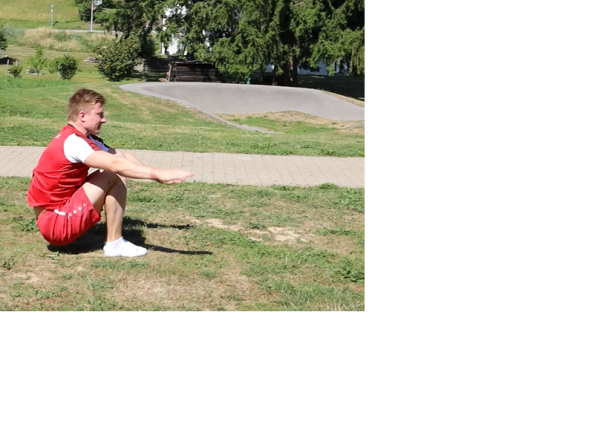








The two rolls are performed one after the other:
Roll fw:
From an upright standing position, perform a forward roll and land back on your feet without using your hands to stand up.
Roll rw:
From a standing position, roll backwards and place your feet on the floor as quickly and as close as possible behind your hands to return to a standing position. Curve the upper body from the top of the head to the tailbone like a tortoise shell during the entire rolling movement. Roll over the upper back and shoulders and not over the head.
The participants practise the form of movement independently using series of pictures or based on the instructor's demonstration of the exercise. The instructor (or a partner) gives feedback, provides support and checks that the exercise is being performed correctly.
4 soft mats (small) ► indoor version
1 row
outdoor:
turf field
Roll forwards
Floor and apparatus gymnastics









From an upright standing position, perform a forward roll and land back on your feet without using your hands when standing up.
The participants practise the movement independently using series of images or based on the instructor's demonstration of the exercise. The instructor (or a partner) gives feedback, provides support and checks that the exercise is being performed correctly.
4 soft mats (small) ► indoor version
1 row
outdoor:
turf field
Roll with raised arms and legs in lateral position left/right
Power
Individual work


Lay on your side, stretch your legs and arms and lift them slightly off the floor. Pull your navel towards your spine and consciously tense your abdomen and then change your side position without changing your body position (roll alternately to the right or left side).
Attention:
Stretched arms and legs practically form a line.
Lighten:
Just hold the position with your arms and legs raised and switch sides from time to time.
Harden:
Add weight to your arms and/or legs.
2-4 weight cuffs/2 weight balls/dumbbells ► Make the exercise more difficult (additional weight)
Rotation of the upper body in frontal stance to the wall (left) ► standing upper body rotation
Power
Individual work

Stand upright in front of a wall, shoulder-width apart (facing the wall), with arms bent (approximately 90 degrees at the elbow joint), holding a medicine ball in front of the body with both hands slightly below chest height. The upper body is turned/rotated as far as possible to the left side (gaze follows the movement), while the legs and arms remain stable (lift the heel on the opposite side - right - as far as possible). Then swing the upper body back to the starting position and at the same time throw the ball (sideways) against the wall. Catch the ball and return to the starting position to restart the exercise.
Attention:
Tighten your stomach, keep your back straight, your pelvis remains in place and only your upper body moves.
Lighten:
Smaller movements (less rotation); lighter ball.
Harden:
Additional weight (on the arms); heavier ball; unstable base.
1 wall
1 medicine ball
1 volleyball or football ► make the exercise easier
2 weight cuffs ► make the exercise more difficult (additional weight)
1-2 balance cushions/1 balance board ► make the exercise more difficult (unstable surface)